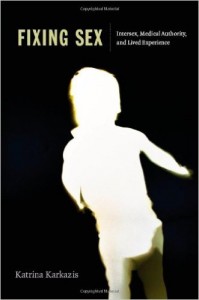 Fixing Sex: Intersex, Medical Authority, and Lived Experience
Fixing Sex: Intersex, Medical Authority, and Lived Experience
by Katrina Karkazis
Duke University Press
384 pages, $23.95 (paper)
MR. JONES was surprisingly relaxed and jovial considering that he had driven two hours from Bakersfield to Los Angeles to have his thirteen-month-old child examined by half a dozen doctors. No doubt he was sustained by his faith: on his T-shirt was boldly emblazoned “Got Jesus?” The examination rooms are usually crowded in the Intersex Clinic (now the Disorders of Sex Development [DSD] Clinic) at UCLA, where experts from pediatric urology, endocrinology, genetics, and psychiatry gather to assess children with DSD and counsel their parents. I am the psychiatrist attending in the clinic and the most recent addition to what had long been exclusively a pediatric urology clinic. However, given the growing controversies over the past two decades concerning corrective genital surgeries in intersex infants, it had seemed prudent to include a variety of specialists in arriving at a consensus on treatment.
Little Ben was an active, well-nourished baby who had had an unusually tumultuous gender history. After the physical exam was completed and the room cleared out, I got to talk to Mr. Jones privately. The Joneses had been told they had a baby boy when he was delivered at a small, rural hospital. But a few days later they received a panicked call from the hospital: “Your child’s a girl! Take him to UCLA right away for surgery to become a girl!” At least that is how Mr. Jones recalled the shocking answering machine message. Chromosome testing had uncovered that Ben was 46XX: he had the normal number of chromosomes (46), but he had two X sex chromosomes instead of the usual XY chromosomes of males. More detailed genetic testing found that he had an SRY gene on one of the X chromosomes.
SRY (Sex-determining Region of the Y) was only identified two decades ago after a half-century hunt for a gene on the Y chromosome that induced the developing embryo to develop testes rather than ovaries.






